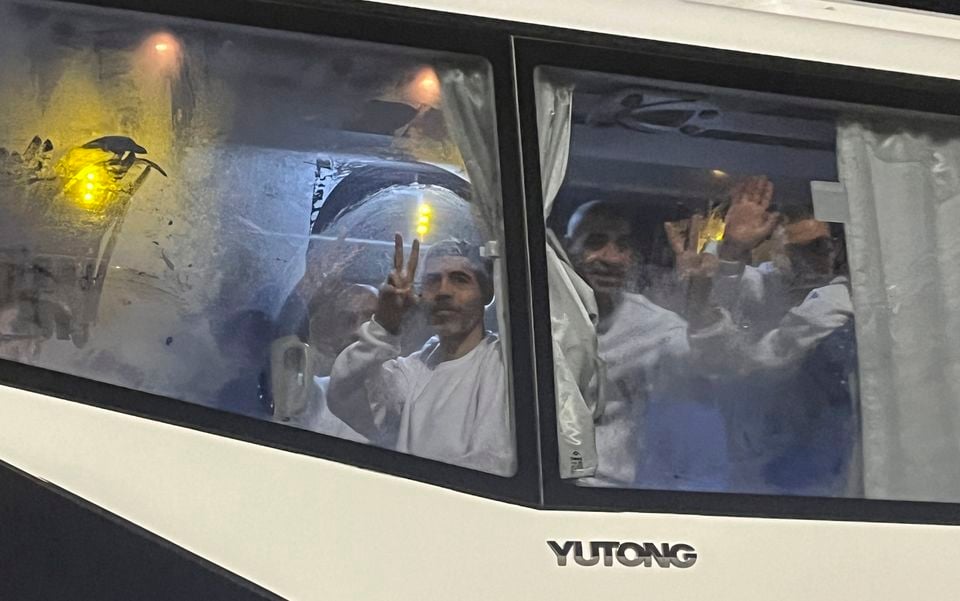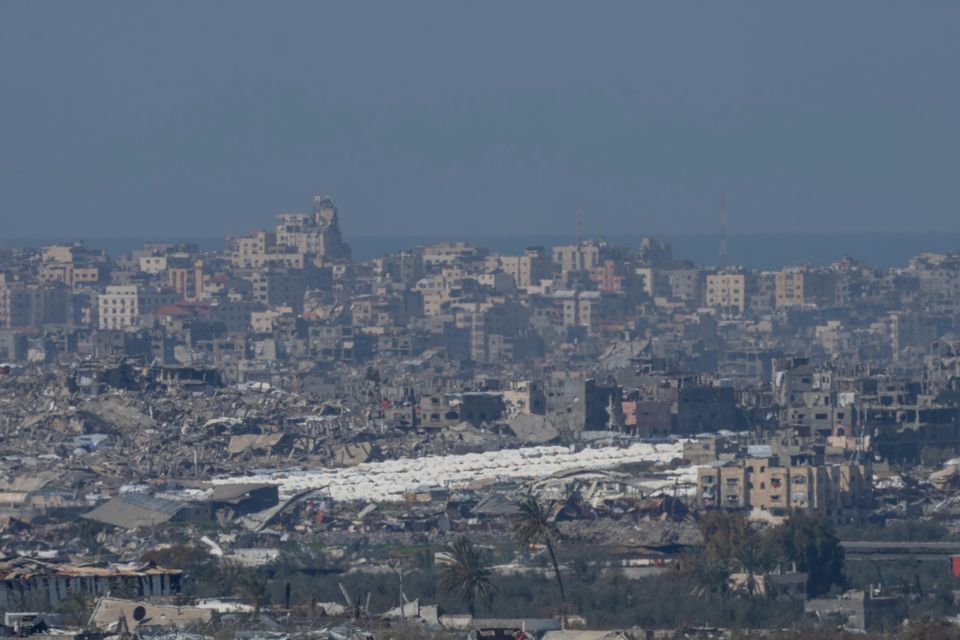Hamas has said it is ready to negotiate the next phase of the ceasefire in the Gaza Strip, after a swap in which it handed over the remains of four hostages in exchange for the release of more than 600 Palestinian prisoners held by Israel.
It was the final such exchange the two sides agreed to as part of a truce that is set to end this weekend.
Negotiations over a second phase, in which Hamas would release dozens of remaining hostages in exchange for more prisoners and a lasting ceasefire, have not yet begun.
An Israeli group representing families of hostages held by Hamas said the remains of all four hostages returned early Thursday have been identified.
Palestinian prisoners wave after being released from an Israeli prison (Mohamed Arafat/AP)
The Hostages and Missing Families Forum identified them as Ohad Yahalomi, Itzhak Elgarat, Shlomo Mantzur and Tsachi Idan.
Mr Mantzur, 85, was killed in the attack on October 7 2023 and his body was taken into Gaza. The other three were abducted alive and the circumstances surrounding their deaths were not known.
Hamas said in a statement that the “only way” for Israel to secure the release of the remaining hostages was through negotiations and adhering to the agreement. It warned that any attempt to pull back from the truce “will only lead to more suffering” for the captives and their families.
Hamas confirmed that more than 600 prisoners had been released overnight. Most were detainees returned to Gaza, where they had been rounded up after the 2023 attack that triggered the war and held without charge on security suspicions.
Some of the released prisoners fell to their knees in gratitude after disembarking from buses in the southern Gaza city of Khan Younis. In the West Bank town of Beitunia, dozens of prisoners were welcomed by crowds of relatives and well-wishers.
The released prisoners, some of whom had been serving life sentences over deadly attacks against Israelis, wore shirts issued by the Israeli prison service bearing a message in Arabic about pursuing one’s enemies. Some of the prisoners threw the shirts on the ground or set them on fire.
Israel delayed the release of the prisoners on Saturday over Hamas’s practice of parading hostages before crowds and cameras during their release. Israel, along with the Red Cross and UN officials, have called the ceremonies humiliating for the hostages.
Hamas released the four bodies to the Red Cross in Gaza overnight without a public ceremony.
Tents are seen among the destroyed buildings in the Gaza Strip (Ohad Zwigenberg/AP)
The prisoners released on Thursday included 445 men, 21 teenagers and one woman, according to lists shared by Palestinian officials that did not specify their ages. Only around 50 Palestinians were released into the occupied West Bank and east Jerusalem in this round, while dozens sentenced to life over deadly attacks against Israelis were exiled.
The latest handover was the final one planned under the ceasefire’s first phase, during which Hamas returned 33 hostages, including eight bodies, in exchange for nearly 2,000 Palestinian prisoners.
The ceasefire’s six-week first phase expires this weekend.
US President Donald Trump’s Middle East envoy, Steve Witkoff, has said he wants the sides to move into negotiations on the second phase. Those talks were supposed to begin in the first week of February.
Israeli Prime Minister Benjamin Netanyahu has vowed to return all the hostages and destroy the military and governing capabilities of Hamas, which remains in control of Gaza. The Trump administration has endorsed both goals.
But it is unclear how Israel would destroy Hamas without resuming the war, and Hamas is unlikely to release the remaining hostages — its main bargaining chips — without a lasting ceasefire.
The ceasefire, brokered by the United States, Egypt and Qatar, ended 15 months of war that erupted after Hamas’s 2023 attack on southern Israel that killed about 1,200 people. About 250 people were taken hostage.
Israel’s military offensive has killed more than 48,000 Palestinians, according to Palestinian health officials, who do not differentiate between civilian and combatant deaths but say more than half the dead have been women and children.
The fighting displaced an estimated 90% of Gaza’s population and decimated the territory’s infrastructure and health system.

